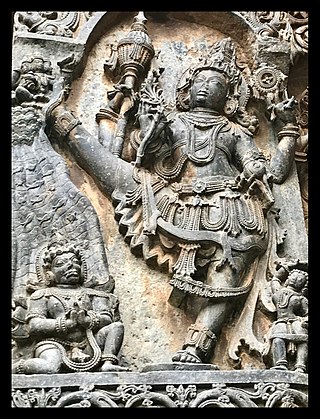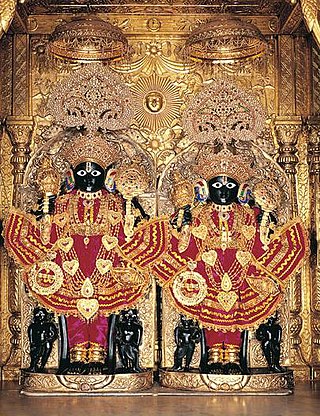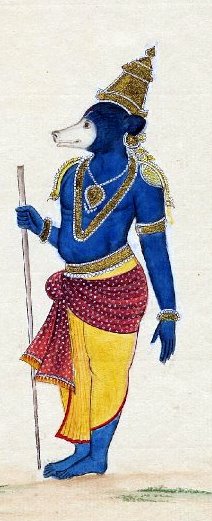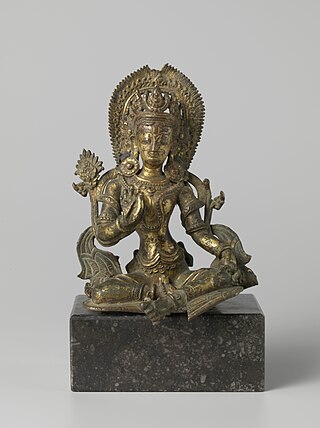Related Research Articles

The daityas are a race of asuras in Hindu mythology, descending from Kashyapa and his wife, Diti. Prominent members of this race include Hiranyaksha, Hiranyakashipu, and Mahabali, all of whom overran the earth, and required three of Vishnu's avataras to be vanquished.

Trailokya literally means "three worlds" It can also refer to "three spheres," "three planes of existence," and "three realms".
The pitrs are the spirits of departed ancestors in Hinduism. Following an individual's death, the performance of the antyesti is regarded to allow the deceased to enter Pitrloka, the abode of one's ancestors. The non-performance of these rituals is believed to result in the fate of wandering the earth as a restless preta.

Janaka was an ancient Hindu king of Videha which was located in Mithila region, approximately in the 8th or 7th century BC. The rulers of the Videha kingdom were called Janakas. He also appears in the epic Ramayana as a father of Sita. His original name was Siradhvaja and he had a brother named Kushadhvaja. His father's name was Hrasvaroman, a descendant of the king Nimi.

Naranarayana, also rendered Nara-Narayana, is a Hindu duo of sage-brothers. Generally regarded to be the partial-incarnation (aṃśa-avatara) of the preserver deity, Vishnu, on earth, Nara-Narayana are described to be the sons of Dharma and Ahimsa.
Danu is a Hindu primordial goddess. She is mentioned in the Rigveda to be the mother of the eponymous race of monsters known as Danavas. The word Danu described the primeval waters that this deity perhaps embodied, as well as dualism and division. In later Hinduism, she is described as the daughter of the Prajapati Daksha and his spouse Panchajani, and the consort of the sage Kashyapa.

Jatayu is a demigod in the Hindu epic Ramayana, who has the form of either an eagle or a vulture. He was the younger son of Aruṇa and his wife Shyeni, the brother of Sampati, as well as the nephew of Garuda. He was also an old friend of King Dasharatha, Rama's father.

Himavat is the personification of the Himalayan mountains in Hinduism. He is the guardian deity of the Himalayas, and finds mention in the epic Mahabharata and other Hindu scriptures.

The Hindu marriage is the most important of all the samskaras, the rites of passage described in the Dharmashastra texts.

Astika is a rishi (sage) featured in Hinduism. He is the son of Jaratkaru by the serpent goddess, Manasa.

Jambavan, also known as Jambavanta, is the king of the bears in Hindu texts.
Nahusha is a king of the Chandravamsha in Hindu mythology. He is described to be the son of Āyus, the eldest son of Pururavas, and Prabha, the daughter of Svarbhānu.

Bhumi, also known as Bhūdevī, is the personification of the earth as a goddess in Hinduism. According to Hindu mythology, Varaha, the third avatar (incarnation) of the god Vishnu, saved her from the asura Hiranyaksha and married her. She is regarded as the mother of Narakasura, Mangala and Sita.

Indrani, also known as Shachi, is the queen of the devas in Hinduism. Described as tantalisingly beautiful, proud and kind, she is the daughter of the asura Puloman and the consort of the king of the devas, Indra.

In Hindu mythology, the danavas are a race descending from Kashyapa and his wife Danu, a daughter of the progenitor god, Daksha. It is mentioned that there are one hundred danavas.

Marichi or Mareechi or Marishi is the mind-born son of Brahma, and one of the Saptarishi in Hindu mythology. He is also the father of Kashyapa, and the grandfather of the devas and the asuras.

Malyavan is a character in Hindu mythology, appearing in the epic Ramayana. A rakshasa, he is the son of Sukesha, and the brother of Mālī and Sumālī. He is described to be a major counsellor to the King of Lanka, Ravana, along with also being the latter's maternal grandfather.
Vishrava, also called Vishravas, is the son of Pulastya, and a powerful rishi (sage), as described in the Hindu epic Ramayana. A scholar par excellence, he earned great powers through the performance of tapasya, which in turn, earned him great name and fame amongst his fellow rishis. He is best known for being the father of the primary antagonist of the Ramayana, Ravana.

Kindama is a rishi featured in the Hindu epic Mahabharata.
References
- ↑ The Upanishads. Penguin UK. 29 January 2004. ISBN 9780141938011.
- ↑ www.wisdomlib.org (17 January 2017). "Puloman: 10 definitions". www.wisdomlib.org. Retrieved 4 August 2022.
- ↑ Danielou, Alain (1 January 2017). The Myths and Gods of India: The Classic Work on Hindu Polytheism. Motilal Banarsidass. p. 287. ISBN 978-81-208-3638-9.